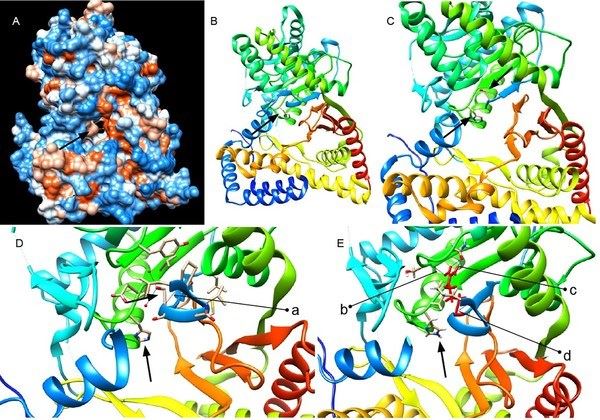What is CHAT Protein
The CHAT protein, or Choline Acetyltransferase, emerges as a molecular linchpin in the intricate web of neurotransmission within the nervous system.
What is CHAT Protein?
Choline Acetyltransferase, encoded by the CHAT gene, is an enzyme pivotal for acetylcholine synthesis. Located predominantly in cholinergic neurons, CHAT catalyzes the transfer of an acetyl group from acetyl coenzyme A to choline, culminating in the production of acetylcholine. This neurotransmitter plays a pivotal role in neuromuscular junctions and various physiological processes, ranging from muscle contraction to cognitive functions.

Figure 1. Human ChAT protein crystal structure and predicted effect of the chatatk64 mutation. (Joshi, S., et al. 2018)
The Function of CHAT Protein
At its core, CHAT protein serves as the architect of acetylcholine production. In the nerve terminal, it orchestrates the conversion of choline and acetyl coenzyme A into acetylcholine. This neurotransmitter, acting as a chemical messenger, facilitates communication between nerve cells, influencing cognitive processes, memory formation, and autonomic nervous system regulation. The precise orchestration of CHAT protein ensures the seamless transmission of nerve signals critical for physiological homeostasis.
CHAT-Related Diseases
Disruptions in CHAT protein function correlate with debilitating disorders. Myasthenia Gravis, an autoimmune condition, manifests when the immune system targets acetylcholine receptors, impeding signal transmission. Congenital Myasthenic Syndrome (CMS), associated with CHAT gene mutations, underscores the critical role of CHAT in neuromuscular transmission. These diseases underscore the indispensability of CHAT in maintaining the delicate balance of neurotransmission.
CHAT Related Signaling Pathways
Understanding the intricacies of CHAT-related signal pathways unravels the complexities of neurotransmission. The cholinergic pathway hinges on CHAT-mediated acetylcholine synthesis, with calcium-triggered vesicle fusion initiating signal transmission. This finely tuned cascade of events highlights the centrality of CHAT in mediating nerve signals, offering a potential target for therapeutic interventions.
Applications of CHAT in Biomedical Research
- Neurological Disorders
CHAT protein's significance extends beyond physiological understanding to therapeutic potential. In neurological disorders like Alzheimer's disease, where acetylcholine signaling is compromised, targeting CHAT could offer novel treatment avenues. Understanding CHAT's role allows researchers to explore interventions for cognitive decline associated with neurodegenerative conditions.
- Drug Development
The pivotal role of CHAT in neurotransmission positions it as a prime target for drug development. Compounds modulating CHAT activity open avenues for therapeutic interventions, either enhancing or inhibiting acetylcholine production. This nuanced approach holds promise for conditions where cholinergic signaling is implicated.
- Neuromuscular Junction Disorders
Beyond myasthenia gravis and CMS, CHAT research broadens our understanding of neuromuscular disorders. Investigating CHAT's involvement in various conditions paves the way for targeted therapies addressing muscle-related disorders, expanding the scope of treatment options.
- Gene Therapy
Advances in gene therapy offer a ray of hope for CHAT-related disorders. Correcting genetic mutations associated with CMS or augmenting CHAT expression through targeted gene therapies presents a transformative approach to address the root causes of these conditions.
- Cognitive Enhancement
Given acetylcholine's pivotal role in cognitive functions, researchers explore modulating CHAT for cognitive enhancement. This avenue holds promise for addressing cognitive decline associated with aging or neurodegenerative diseases, opening new horizons for enhancing human cognition.
The precision of CHAT in orchestrating neurotransmission opens new vistas for therapeutic interventions, promising breakthroughs in the ever-evolving landscape of molecular biology and medicine.
Recommended Products for CHAT Protein
| Cat.# | Species | Product name | Source (Host) | Tag |
|---|---|---|---|---|
| CHAT-176H | Human | Recombinant Human CHAT protein, GST-tagged | Wheat Germ | GST |
| CHAT-172H | Human | Recombinant Human CHAT protein, His-tagged | E.coli | His |
| CHAT-174H | Human | Recombinant Human CHAT | Mammalian Cell | His |
| CHAT-175HCL | Human | Recombinant Human CHAT HEK293T cell lysate | HEK293T | Myc/DDK |
| CHAT-1021H | Human | Recombinant Human CHAT Protein (Met1-Pro630), N-His tagged | E.coli | N-His |
| CHAT-2464H | Human | Recombinant Human CHAT protein, His-tagged | E.coli | His |
| CHAT-2666H | Human | Recombinant Human CHAT Protein, His (Fc)-Avi-tagged | HEK293 | His (Fc)-Avi |
| CHAT-1359H | Human | Recombinant Human CHAT protein, His&Myc-tagged | E.coli | His&Myc |
| Chat-1836R | Rat | Recombinant Rat Choline O-Acetyltransferase | E.coli | N/A |
| CHAT-6178C | Chicken | Recombinant Chicken CHAT | Mammalian Cell | His |
Reference
- Joshi, S., et al. Mutation of a serine near the catalytic site of the choline acetyltransferase a gene almost completely abolishes motility of the zebrafish embryo. PLoS One. 2018, 13(11): e0207747.

